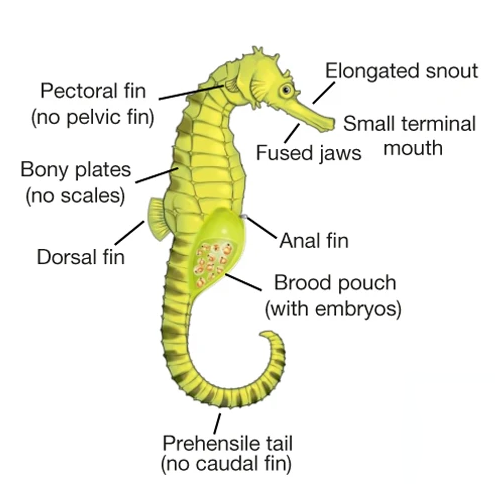The Biomechanics of Seahorses: How They Defy Conventional Fish Anatomy
Seahorses, those enchanting creatures of the sea, have long captured the imagination of marine enthusiasts and scientists alike. Their unique appearance, with a horse-like head, prehensile tail, and a distinct lack of scales, sets them apart from the conventional fish anatomy we are accustomed to. Yet, it is not just their appearance that makes seahorses fascinating; it is their biomechanics, the intricate workings of their bodies, that truly defy the norms of underwater life.
A Closer Look at Seahorse Anatomy
At first glance, a seahorse might seem like a whimsical creation of nature, but a deeper understanding of their anatomy reveals a remarkable adaptation to their environment. Unlike typical fish with streamlined bodies, seahorses possess an upright posture, which makes them stand out in the underwater world. Their distinctive horse-shaped head is not just for aesthetics; it plays a crucial role in their feeding habits.
Biomechanics of the Seahorse Head: Precision in Motion
The seahorse head is a marvel of biomechanical design. It can move in multiple directions, allowing the seahorse to precisely target and capture its prey. This ability is essential for survival, as seahorses are ambush predators. They rely on stealth and precision to catch small crustaceans and plankton, their primary sources of sustenance. The intricate biomechanics of their heads give them a competitive advantage in the ever-challenging underwater hunt for food.
The Prehensile Tail: A Versatile Tool for Survival
One of the most distinctive features of a seahorse is its prehensile tail. Unlike other fish that use their tails for propulsion, seahorses utilize theirs as a gripping tool. This adaptation is particularly useful in environments with a lot of vegetation or coral, where the seahorse can anchor itself to avoid being carried away by strong currents.
Biomechanics of the Seahorse Tail: Strength and Flexibility
The seahorse tail is a marvel of strength and flexibility. Composed of numerous bony plates, it can coil and uncoil with remarkable precision. This allows the seahorse to grasp and hold onto various substrates, ensuring its stability in the ever-changing underwater currents. The tail’s ability to wrap around objects also serves as a means of camouflage, helping the seahorse blend seamlessly into its surroundings.
Reproduction: A Role Reversal in the Underwater Realm
In the world of seahorses, reproduction takes an unconventional turn compared to other fish species. It is the males, not the females, who become pregnant and carry the developing embryos. This role reversal is a unique aspect of seahorse biology and adds another layer to their already intriguing biomechanics.
Biomechanics of Seahorse Pregnancy: Nature’s Marvel
Male seahorses have a specialized pouch where the female deposits her eggs. The male then undergoes a pregnancy-like process, nourishing and protecting the developing embryos within the pouch. The pouch itself is equipped with intricate mechanisms that ensure the proper exchange of nutrients and oxygen. This fascinating adaptation challenges traditional gender roles in the animal kingdom and showcases the complexity of seahorse biomechanics.
Conservation Challenges: Seahorses in Peril
While seahorses have evolved remarkable biomechanical features, they face numerous threats in their natural habitats. Overfishing, habitat destruction, and the aquarium trade pose significant challenges to seahorse populations worldwide. Understanding their biomechanics not only deepens our appreciation for these unique creatures but also underscores the importance of conservation efforts to protect their fragile ecosystems.
Biomechanics and Conservation: A Call to Action
Conservation initiatives must take into account the intricacies of seahorse biomechanics. Preserving their habitats, implementing sustainable fishing practices, and raising awareness about the importance of these marine wonders are crucial steps in ensuring the long-term survival of seahorse populations. By appreciating the biomechanical marvels of seahorses, we can inspire collective action to safeguard their future.
Frequently Asked Questions (FAQs)
Q1: Can seahorses swim like other fish?
A1: While seahorses are not known for their speed, they can swim using a small fin on their back, allowing them to navigate and move through the water. However, their preferred method of travel is often their prehensile tail, which they use to anchor themselves to underwater structures.
Q2: Do seahorses make good aquarium pets?
A2: Seahorses present unique challenges in captivity. Their specific habitat requirements, specialized diet, and vulnerability to stress make them challenging to care for. In many cases, their capture for the aquarium trade contributes to the decline of wild populations.
Q3: How long do seahorses live?
A3: The lifespan of a seahorse varies among species, but on average, they live for about three to five years in the wild. Proper habitat conditions and a steady supply of suitable food are crucial factors in determining their lifespan.

